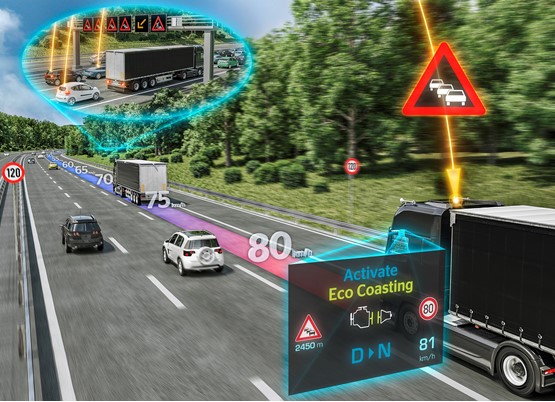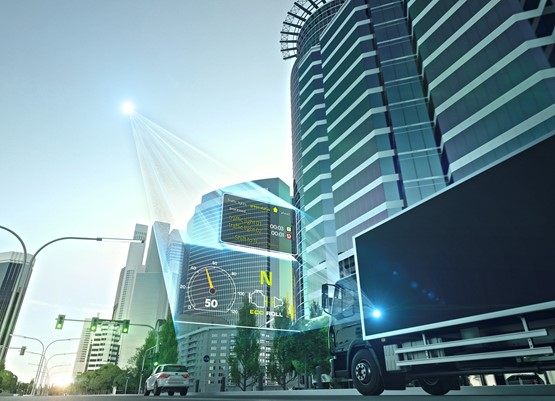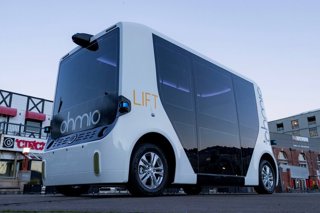Continental executive says that the savings from going driverless will quickly compensate for any fully-autonomous price premium. By Steve Banner
Driverless trucks look set to become a practical proposition over the next decade and could be operating on public highways by 2026.
So says Michael Ruf (below), head of business unit, commercial vehicles and aftermarket, at global automotive components giant Continental.
A key advantage for operators is the major cost saving they will offer, he says, given that drivers’ wages typically make up around 29% of operational expenditure.
Furthermore, if you no longer need truck drivers then you have no need to worry about the continuing driver shortage.

If a truck does not require a driver then it has no requirement for a conventional cab with a driver’s seat and steering wheel. One potential benefit is the ability to make it a lot more aerodynamic, delivering energy savings.
The savings that can be garnered overall should more than offset the price premium fully-autonomous trucks are likely to attract, given the sophisticated technology they will rely on.
Fleets could see their money back in no more than a year, he reckons; and driverless trucks can operate 24/7.
Clearly politicians, regulators, insurance companies and citizens in general will have plenty to say about driverless, and will expect cyber security to be a priority. Nobody wants a terrorist to get remote control of a tanker with 40,000 litres of fuel on board.
“Society has to be confident that nothing will happen to those vehicles with their heavy loads,” Ruf observes.
By the time fully-autonomous trucks arrive, the transport industry will hopefully have got to grips with the problem of wasteful empty running.
“It currently averages out at 20% to 25% across Europe rising to 35% to 37% in Germany,” Ruf says. “It’s a waste of fuel and results in more CO2 emissions.”
Reducing it is likely to involve the introduction of technology which will detect when a truck’s load area is partially or fully empty and offer the vacant load space to firms that need cargo transported.
Doing so will mean that more revenue will be generated for fleets and trucks will be operated more efficiently.
Another way of achieving better efficiency is to anticipate what is happening on the highway some distance ahead and ensure your trucks respond accordingly.
With this in mind, Continental has just unveiled a dynamic version of eHorizon which it says should enable fleets to save up to 2% more fuel compared with the current iteration.
“It ushers in a new era in the control of vehicle systems because it detects events that take place while the vehicle is on the road,” says Ruf.
The current eHorizon uses detailed topographic route data plus a GPS signal to send information on the highway ahead to the truck which amends its driving speed and style accordingly.

Dynamic eHorizon adds real-time traffic flow data updated every minute. It is transmitted to the truck via the mobile wireless network, allowing it to ‘see’ ahead for several miles with enhanced accuracy.
Should slow-moving vehicles be detected then eHorizon can use predictive algorithms to trigger downshifting, braking or coasting.
If coasting looks as though it will reduce fuel usage then the driver is told so by a blue flashing light in the cab plus a symbol on the instrument panel. EcoCoasting cuts in just as soon as the accelerator pedal is released which causes the light to glow a steady blue.
Depress the accelerator pedal again and EcoCoasting is over-ridden.
Urban drivers are regularly faced with the risks posed by wayward pedestrians and cyclists, and Continental has been busy developing systems that should help them to cope.
The technology it is working on uses artificial intelligence (AI) to foresee the next move unpredictable vulnerable road users are likely to make.
Its AI experts are working on gesture recognition. It uses machine-learning and imaging techniques to spot somebody standing on the edge of a pavement and work out what he or she is going to do next.
Perhaps the body language suggests the pedestrian is not really conscious of what is going on around them and is about to step off the kerb and under the truck’s front wheels.
If that looks likely then the truck can anticipate it and brake before it happens. A gesture-recognition-based system could be available by 2023, says Continental.
Anticipating and responding to people’s intentions in this way places significant demands on the technology employed.
“We must observe the fine line between normal and critical traffic situations so the system issues a warning or triggers emergency braking only when there is a real danger,” says Christian Eilers, software project manager at Continental’s Computer Vision Lab. “We call this the prevention of false positives.”
Continental already has radar-based sensors available which can detect the presence of a cyclist in the truck’s blind spot. A pulsating LED light strip in the cab or an acoustic signal is used to warn the driver.

Continental intends to augment the sensors with cameras that can continually sweep the nearby infrastructure, taking the position of kerbs, litter bins and bus stops into account to make the warning more accurate; with AI added to determine the bike rider’s next move.
If the technology is reliable and accurate enough, then it can be incorporated into the truck’s automated emergency braking system (AEBS). That could transform it into a more-effective life-saver because the vehicle will apply the brakes automatically if it recognises someone is at risk.
Turning to the topic of Drivers Hours, all newly-registered trucks will have to be fitted with what is known as a smart tachograph from June 15, 2019.
It will enable enforcement agents standing at the edge of the highway to detect certain irregularities as the truck goes by – assuming they have the necessary equipment – so that enforcement action can be taken by their colleagues a few miles down the road, says Continental.
A driver may have failed to insert his digital card, for instance.
Continental’s response is the DTCO 4.0 tachograph.
As well as allowing the truck’s location to be automatically recorded at the start and end of the driver’s shift using GPS in line with smart tachograph legislation, it can be used to transmit and receive a variety of other data securely thanks to new encryption protocols.
In some countries, this could enable the vehicle to talk to the road tolling system without the need to fit other devices. This could include the transmission of weight data from sensors mounted on the truck’s axles to make toll charges more equitable, Continental suggests.
Apps could use data from DTCO 4.0 to guide drivers to an empty parking space at a truck stop if they need to take a statutory break or to the nearest fuel station, Continental says. Information from the unit could also be used to help work out insurance rates, it adds.
“Telematics data can be compared to uncut diamonds,” says Continental vice president of segment tachographs, telematics, and services, Lutz Scholten.
“They have great potential but in many cases they simply aren’t available in a form on which you can build business relationships because they are not sufficiently trustworthy and authenticated.
“However, the tachograph is now becoming a comprehensive, authenticated data source for all telematics processes,” he contends. “It brings new opportunities for fleets and for their service providers.”

















Login to comment
Comments
No comments have been made yet.